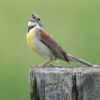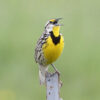Jean Favara, Vice President of Conservation
The consequences of climate change are hard to ignore. NASA has classified 2020 as tied with 2016 as the hottest year on record. Weather patterns are shifting in response to warmer temperatures and yielding severe droughts, increased frequency and intensity of flooding, storms, and wildfires, and a rise in ocean levels that encroach on our coastal wetlands and endanger our cities. These effects impact us, plants, and the wildlife that depend on the specific timing of resources to survive and thrive.
National Audubon Society (NAS) has used science to study how birds will be impacted by climate change. The “Survival by Degrees: 389 Bird Species on the Brink” report summarizes this information. Explore the Birds and Climate Visualizer and input your state and discover how your local birds could be affected by climate change, what climate policies are in place in Missouri and a map of what specific climate threats impact our state.
NAS has classified 13 Missouri bird species, including Scarlet Tanagers, as highly vulnerable to climate change in Missouri. They are found here in the spring and summer breeding in our oak and hickory forests. This bird is a treat to see with the male sporting a red head and body accented by black wings and a song that includes a characteristic “chick-bree” phrase. With a 3.0 ⁰warming scenario, Scarlet Tanagers will lose 68% of their range in Missouri and can be impacted by threats such as spring heat waves, heavy rain, and urbanization. Reducing warming to a 2.0 ⁰ rise decreases the range reduction to 47%. At 1.5⁰ warming, a goal that requires our immediate action to maintain, this species will lose 32% of its Missouri range.
With our increased understanding of the impacts of climate change, it is easy to become discouraged. No doubt climate change will test our ingenuity, determination, and ability to unite behind a common goal. But the science also tells us that there is hope. For the Scarlet Tanager, limiting warming to 1.5 ⁰ decreases the range loss of this bird and alleviates the other identified threats.
What can you do? Explore ways to support birds in your backyard by planting and utilizing natives. St. Louis Audubon Society’s Bring Conservation Home program is a place to start. Advocate for increased use of renewable energy sources in Missouri. COVID-19 has clearly shown us we can reduce our use of fossil fuels. In-person social interactions remain important, but we should reexamine our use of vehicles to travel to work and meetings. Individual actions can make a difference and help ensure that future generations will enjoy the beauty and song of the Scarlet Tanager in our Missouri forests.
Photo Credit: Scarlet Tanager, Al Smith




